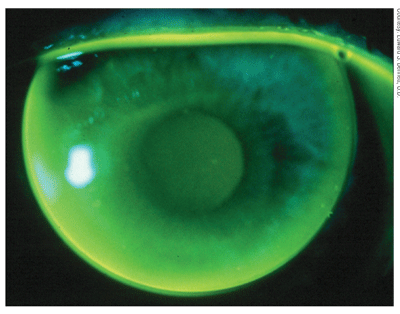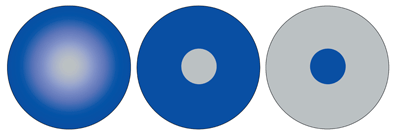Although monovision remains the most commonly used contact lens strategy for presbyopic correction, multifocal contact lenses are gaining ground in key areas. In a recent study, most patients, when given a choice, preferred the vision provided by multifocal lenses to that provided by monovision.1 Soft multifocal lenses are designed for simultaneous vision, in which light rays pass through distance and near zones at the same time. Simultaneous vision lenses can be manufactured with aspheric curves (left) or concentric configurations.
However, O.D.s who do not fit multifocals as their first-line modality have refrained not so much for clinical reasons as for practice management ones. Multifocal fits take longer than monovision and usually entail more follow-up visits. So much extra time spent with the patient could eat into practice revenues, some believe.
Others, however, believe that this kind of thinking belongs in the past and that forward-looking optometrists should be moving toward a service-oriented practice model vs. the traditional materials-oriented one. If providing the best possible vision for the patient requires some additional chair time, they say, then so be it. But, in turn, the patient must understand that he or she will be charged extra for such service.
The generation now becoming presbyopic has grown up with contact lenses. Further, they are often willing to try new things and spend extra for the sake of better vision and/or avoiding reading glasses. With these patients, the path of least resistance amounts simply to a waste of opportunity.
Multifocal vs. Monovision
Researchers at the Ohio State University College of Optometry in Columbus, Ohio, randomized 38 presbyopic patients to be fit into multifocal lenses or monovision for one month and measured visual performance in high- and low-contrast visual acuity at distance and near and near stereoacuity.1 They also measured patient satisfaction using the National Eye Institute Refractive Error Quality of Life Instrument questionnaire and by asking the patients which lens system they preferred.

A well-fit aspheric multifocal gas permeable lens. Researchers cite increased stereoacuity as the most likely source of popularity of multifocal contact lenses.
The researchers found that patients maintained at least 20/20 binocular vision at distance and near with both multifocals and monovision in high-contrast conditions. In low-contrast conditions, patients lost less than a line of vision in both lens systems at distance. In the same conditions, however, the multifocal group lost five to six letters at near, while the monovision group lost only two letters. When asked, 76% of patients said they preferred the multifocals, while 24% preferred monovision.
The authors cited increased stereoacuitybetter in some patients than what they experienced with their previous vision correctionas the most likely source of popularity of multifocal contact lenses despite the slightly improved acuity provided by monovision. Stereoacuity was improved in the multifocal group by an average of 79 seconds of arc.
Lack of stereoacuity with monovision is often downplayed in the literature, the researchers say, but it may play a bigger role than previously believed. For example, one study found that failed monovision wearers had larger losses of distance and near stereoacuity than successful monovision patients.2
Gaining Support
Alan N. Glazier, O.D., of Rockville, Md., says he tries to fit his presbyopic patients with multifocals first; if unsuccessful, he switches to modified monovision. He reserves normal monovision as a last-ditch effort to keep the patient in lenses. I look at monovision as a 20-year-old car, he says. Nobody is driving one unless they have to.
Advances in the technology and design of multifocal lenses have greatly increased his success rate, he says. Some 70% to 80% of these patients in his practice become permanent multifocal wearers.
San Diego optometrist Brian Chou also believes that multifocals provide better vision. My clinical experience has been most patients do indeed prefer the vision of multifocals, he says. But, it is also true that monovision is still going to be part of the armamentarium for practitioners.
New York optometrist Susan A. Resnick says she only fits patients who have less than 1.00D of presbyopia in monovision. But once it gets higher than that, we will choose some sort of multifocal system, she says.
Most practitioners we talked with believe that gas permeable (GP) contact lenses offer the best multifocal vision. Generally, the optical surfaces of GPs provide clearer vision, they say. Also, GPs offer a translating vision design, which typically contains prism ballast and truncation to stabilize the near segment and facilitate translation. When viewing a distance object, the near segment remains below the line of sight. When the patient looks down to read, the lens moves up, or translates, positioning the near segment in the line of sight. This allows for clear distance and near images even in higher powers.
Soft multifocal lenses, by contrast, are designed for simultaneous vision, in which light rays pass through distance and near zones at the same time. Translating vision is generally considered better than simultaneous vision at providing multifocal vision. Even so, newer designs in recent years have shown that simultaneous viewing lenses can work for many patients when designed in certain configurations, such as rear-surface aspheric (center distance lens), front-surface aspheric (center near lens) and concentric or annular design.3
Because of comfort issues, O.D.s may be more reluctant to offer GPs as a first choice for presbyopes. But this reluctance may be unfounded. I think we worry about it more than the patients do, says Edward S. Bennett, O.D., of University of St. Louis School of Optometry and executive director of the Gas Permeable Lens Institute.
Dr. Bennett presents multifocal GPs as the primary option for his presbyopes; about 80% of those patients remain in these lenses and are satisfied with their vision, he says.
Many O.D.s are awaiting the SynergEyes M multifocal contact lens. The lens was approved by the FDA in 2005 and is expected to be available in mid-2007. This lens combines a GP center with a soft outer ring. The designers hope it will provide the comfort of a soft lens with the visual acuity of a GP.

Setting Expectations
An important aspect of fitting presbyopes is making sure patients understand that even under the best circumstances, their vision will not be perfect. I tell my patients that with single-vision lenses, you can see the length of three football fields, Dr. Glazier says. In multifocals, you may see one-and-a-half to two football fields.
That extra 100 yards usually is necessary only if the patient does a lot of night driving or attends sporting events, he says. In those cases, a pair of single-vision spectacles worn over the lenses can provide that additional distance.
It is also vital to figure out what kind of vision is best suited for the patient. Some questions to ask:
How many hours a day does the patient typically spend at a computer? Computer users will have a great need for intermediate vision, as will plumbers, electricians and mechanics.
In what hobbies and sports activities does the patient participate? For example, does he or she like to read, play golf or do needlepoint?
How much time does the patient spend in a car? A patient who does a lot of driving at night will want to avoid halos and glare.
Rather than using chair time asking all these questions, some practitioners have patients fill out a standard questionnaire.
Reducing Chair Time
Additional follow-up visits take up a lot of time. Dr. Resnicks advice: You want to have on hand as wide an inventory as you can of your best lens designs, your workhorse lenses. Do as much of the pretesting as you can with loose trial lenses.
Have the patient remain in the lenses for about 10 minutes. Meanwhile, allow him or her to walk around the office, read pamphlets and sit in front of a computer if possible. Patients should experience at least some level of comfort.
If they are really unhappy at that first fitting, they are probably going to be unhappy at their next visit as well, she says. We like to think that adaptation plays a bigger role than it does. But I have learned from experience that you cannot send a person out if they are really uncomfortable and tell them it is going to get better, because it does not.
Billing for Service
In 1994, optometrists made about 28% of their revenues from contact lenses, but as of mid-2005, the figure was less than 20%, according to the Practice Resource Management Inc., an optometric consulting firm in Lake Oswego, Ore. This drop-off occurred in the early part of this decade, when consumers became comfortable purchasing items on the Internet and began doing so in greater numbers.
To counteract this loss of revenue, optometrists should focus on providing quality service rather than products. A lot of optometrists still do not charge appropriately for their contact lens services, Dr. Chou says. If they charged appropriately for their chair time, fitting multifocals would be a profitable activity, he says.
Now that lens designs and materials allow for successful fitting of multifocal lenses, the biggest challenge for adding these lenses to a practice is increased chair time, Dr. Resnick says.
But for some optometrists, the real challenge is still the modality itself. The first step is to believe in these lenses, she says. Many still dont. And, that is why they dont fit them.
Mr. Celia is a free-lance health-care writer based in the Philadelphia area.
1. Richdale K, Mitchell GLM, Zadnik K. Comparison of multifocal monovision soft contact lens corrections in patients with low-astigmatic presbyopia. Optom Vis Sci 2006 May;83(5):266-73.
2. Back A. Factors influencing success and failure in monovision. ICLC, 1995;22:167-171.
3. Spinelli MR, Silbert JA. Contact lenses: the challenge and the ecstasy. Rev Optom 2000 Dec 15;137(12):40-50.

